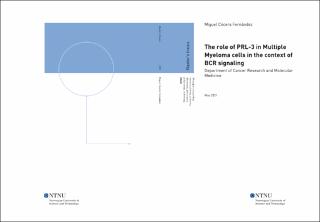| dc.description.abstract | Mylomatose, eller Multiple Myloma (MM) er en B-cellet ondartet kreftart som er kjennetegnet av samling og spredning av plastmaceller som utskiller antistoffer igjennom beinmargen. MM er en sykdom med høy genetisk heterogenitet og sakte progresjon. Selv med ny utvikling innen forskning, og nye behandlingsformer er den fortsatt sett på som uhelbredelig. Derfor er det svært viktig å finne nye mål og behandlinger. PRL-3 er en fosfatase som er blitt beskrevet til å ha en viktig rolle i spredning av plasmaceller i flere ondartede krefttyper. I tillegg er PRL-3 aktivert av IL-6 stimulering, som er en viktig vekstfaktor for MM celler.
I denne masteroppgaven analyserte vi endringer forårsaket av PRL-3 i fosfoproteomet. Denne analysen viser at PRL-3 under stimulasjon av IL-6 kan dysregulere fosforylering av proteiner som er relatert til ulike reaksjonsveier som CD-28 stimulering, B celle reseptor (BCR) signalering, cellesyklus og interleukin signalering. I tillegg, var de biologiske prosessene funnet relatert til post-translasjon modifiseringer av proteiner, mRNA spleising og utvikling av hjertet. Etter å ha studert ulike reaksjonsveier, bestemte vi oss for å sette søkelys på BCR signalering siden vi fikk uventede resultater. I utgangspunktet forventet vi ikke at denne reaksjonsveien skulle være relevant for differensierte plasmaceller.
Våre funn viser at c-CBL er overuttrykt og overfosforylert (y674) som en konsekvens av at PRL-3 er overuttrykt. Vi bekreftet også det faktum at PRL-3 overuttrykning leder til overaktivisering av LYN. Vi foreslår at dette kan beskytte PRL-3 celler mot LYN hemming med bafetinib. I tillegg foreslår vi at PRL-3 overuttrykning kan vedlikeholde aktiveringen av NF-kB reaksjonsveien når den er behandlet med en moderat hemmende konsentrasjon (5µM). PRL-3 virker ikke å være relatert til andre viktige tyrosin kinaser for BCR signalering som SYK og BTK. Våre resultater indikerer at PRL-3 ikke er relatert til hverken overuttrykning eller oppfosforylisering av BTK. Dessuten er det mulig at PRL-3 kan nedregulere BTK uttrykk og dens fosforylering på y551 rester, som er den katalytiske delen på proteinet. Denne forskjellen i utrykk og aktivitetsnivå ble ikke sett som en fordel når BTK hemming ble testet. Til tross for at SYK hemming kan indusere celledød i INA-6 celler, så gir ikke PRL-3 noen fordel mot SYK hemming.
Til konklusjon, etter å ha gjennomgått alle resultatene kan vi ikke bekrefte at celler som bruker PRL-3 til å aktivere BCR signalering øker celledeling og spredning. Likevel så kan vi ikke forkaste relevansen av BCR signalering for MM cellers utvikling. | |
| dc.description.abstract | Multiple Myeloma (MM) is B-cell malignancy characterized by the accumulation and dissemination of antibody-secreting plasma cells throughout the bone marrow. MM is a disease with a high genomic heterogeneity with a slow progression. Despite the new advances and new treatments is still regarded as incurable, therefore, the finding of new targets and treatments are crucial. PRL-3 is a phosphatase that has been described to have an important role in migration in several malignancies. This role has been suggested to be important for malignant plasma cells migration. In addition, PRL-3 is activated by IL-6 stimulation, and important growth factor for MM cells.
In this thesis we analysed the alterations caused by PRL-3 in the phosphoproteome. This analysis revealed that PRL-3 under the stimulation of IL-6 can dysregulate the phosphorylation state of proteins related with several pathways such as, CD-28 stimulation, BCR signaling, cell cycle and interleukin signaling. In addition, the biological processes detected were related with protein post-translational modification, mRNA splicing, and cardiac development. After considering the study of the different pathways, we decided to focus on the B cell receptor (BCR) signaling, as it was an unexpected result, due to this pathway should not be relevant in differentiated plasma cells.
Our findings show that c-CBL is over-expressed and over-phosphorylated (y674) as a consequence of PRL-3 overexpression. Moreover, we confirmed a fact shown previously, that PRL-3 overexpression leads to the overactivation of LYN. We also suggest that this fact can protect PRL-3 cells against LYN inhibition with bafetinib. We also propose that PRL-3 overexpression can maintain the activation of this NF-κB pathway when is treated with a moderate inhibitor concentration (5µM). However, PRL-3 seems to not be related with other important tyrosine kinases for the BCR signaling, such as SYK or BTK. Our results indicate the PRL-3 is not related with the neither the overexpression nor the up-phosphorylation of BTK. Moreover, is possible that PRL-3 can downregulate BTK expression, and its phosphorylation on the y551 residue, the catalytic site of the protein. This differences in the expression and activity level, are not translated into any significant benefit, when BTK inhibition was tested. In addition, despite SYK inhibition can induce cell death in INA-6 cells, PRL-3 does not confer any advantage, against SYK inhibition.
In conclusion, after compiling all the results we cannot confirm that cells use PRL-3 to activate the BCR signaling to increase the cell proliferation and migration. However, we cannot discard the relevance of BCR signaling for MM cells´ development. | |
